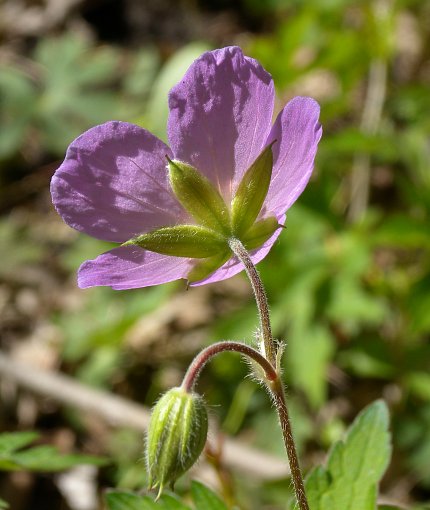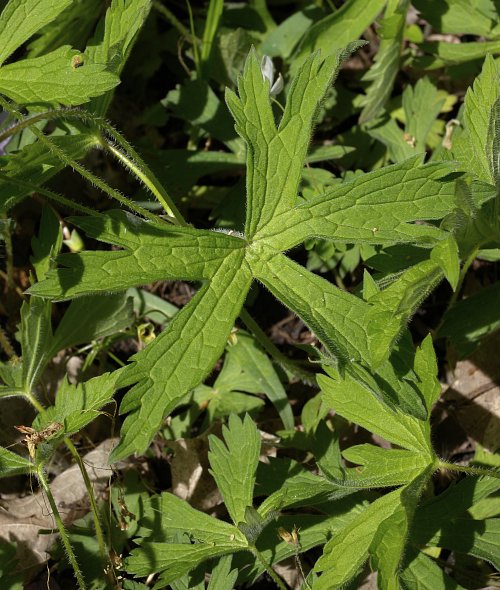Description: This herbaceous perennial plant is 1-2½' tall, consisting of a loose cluster of basal leaves and flowering stems that develop directly from the creeping rootstock. On the lower portion of each flowering stem, there is a pair of opposite leaves. Both the basal leaves and the lower opposite leaves of the flowering stems have a similar appearance. They are up to 5" long and across, and palmately cleft with 5 deep lobes. Each of these lobes is wedge-shaped at the base. The leaf margins have a few secondary lobes and coarse teeth. The upper pairs of leaves on the flowering stems are like the lower leaves, except they are smaller in size and they usually have 3 primary lobes, rather than 5. The upper leaf surface is medium green with fine appressed hairs. The long petioles of these leaves are light green, terete, and coarsely hairy. The flowering stalks (peduncles) are up to 6" long and ascending to erect; like the stems with opposite leaves, they are light green to reddish brown, terete, and coarsely hairy.

Each flowering stalk terminates in a floppy corymb or umbel of 2-5 flowers; sometimes only a single flower is produced. Each flower is about 1–1¼" across, consisting of 5 rounded petals, 5 green sepals, 10 stamens with pale yellow anthers, and a single pistil with 5 carpels. The petals are pale purplish pink and obovate with rounded tips; they have fine veins radiating across their surfaces that function as nectar guides. The sepals are light green, hairy, lanceolate-oblong or elliptic-oblong in shape, and cuspidate (tapering abruptly into short narrow tips); they are shorter than the petals. Both the flowering stalks (peduncles) and pedicels have non-glandular hairs. The blooming period occurs during the late spring to early summer, lasting about 1 month. The pistil of the flower elongates into a beak-like fruit about 1–1½" long. As it matures, the 5 slender carpels of this fruit curl upward and backward to fling the seeds from the mother plant. The seed surface is reticulated. The root system consists of a dark stout rootstock that produces rhizomes; it is high in tannins. This plant often forms colonies.

Cultivation:
The preference is light shade to partial sunlight, moist to slightly
dry conditions, and rich loamy soil with abundant organic matter. This
plant also tolerates full sunlight if there is sufficient moisture in
the soil. It is one of the easier woodland
species to cultivate.
Range & Habitat:
The native Wild Geranium is a common plant of woodlands that occurs in
all counties of Illinois (see Distribution
Map). Habitats include both
floodplain and upland woodlands, savannas, meadows in wooded areas,
semi-shaded seeps, and rocky glades. Sometimes it invades hill prairies
from adjacent wooded areas. Wild Geranium is a typical species of mesic
deciduous woodlands.

Faunal Associations: The nectar and pollen of the flowers attract bumblebees, mason bees (Osmia spp.), cuckoo bees (Nomada spp.), long-horned bees (Synhalonia spp.), Halictid bees (Lasioglossum spp., etc.), Andrenid bees (Andrena spp.), and other bees. An Andrenid bee, Andrena distans, is a specialist pollinator (oligolege) of Wild Geranium (Geranium maculatum). The flowers also attract Syrphid flies, dance flies (Empis spp.), butterflies, and skippers. Other insects feed on the leaves and other parts of Wild Geranium. This includes leaf-mining larvae of the beetle Pachyschelus purpureus, Acyrthosiphon malvae (Geranium Aphid) and Macrosiphum geranii (Wild Geranium Aphid), Metriorrhynchomiris dislocatus (Yellow Plant Bug), burrowing bugs (Sehirus spp.), stink bugs (Euschistus spp.), and ebony bugs (Corimelaena spp.). The caterpillars of some moths species also feed on Wild Geranium and other Geranium spp., including Lacinipolia lorea (Bridled Arches), Heliothis virescens (Geranium Budworm Moth, Tobacco Budworm Moth), and Archips purpurana (Omnivorous Leafroller Moth). Among vertebrate animals, the Eastern Chipmunk sometimes eats the seeds, while the White-tailed Deer occasionally browses on the foliage.

Photographic
Location:
A flower garden at Crystal Lake Park in Urbana, Illinois, and Busey
Woods in the same city.
Comments:
The Wild Geranium (Geranium
maculatum) is the showiest of the native geraniums in
Illinois with flowers
at least 1" across. All of the others are far less showy because they
have smaller flowers. There is a European species, Geranium
pratense (Meadow Geranium), with equally large flowers, but
it has not been observed in the wild in Illinois. This species has a
similar appearance to the Wild Geranium, except that the hairs on its
flowering stalks and pedicels are sticky-glandular, and its leaves are
more divided and finely cut. Another European species, Geranium
sanguineum (Long-Stalked Geranium), is rarely observed as a
naturalized plant in
Illinois. It has flowers with notched petals and its leaves are smaller
in size.